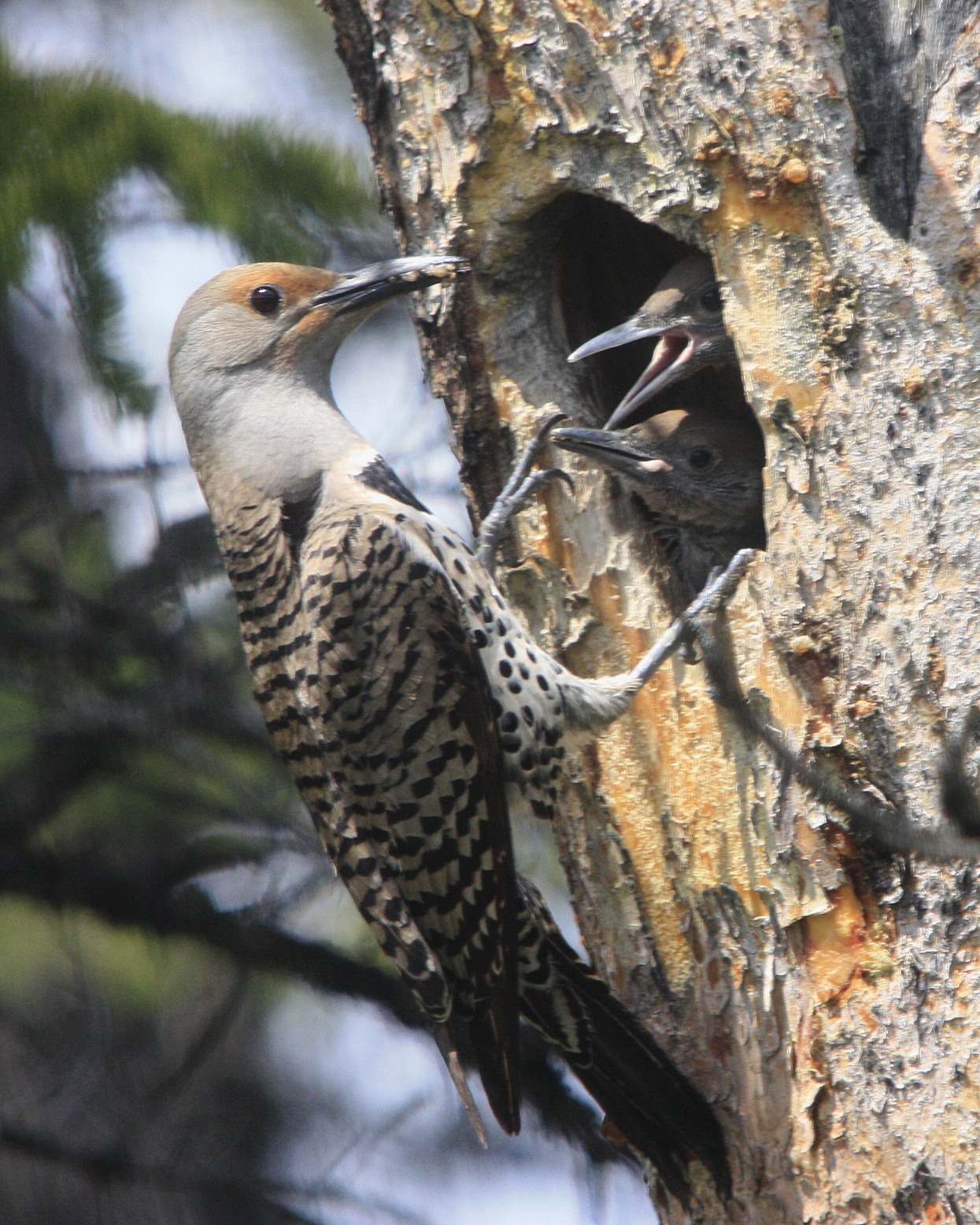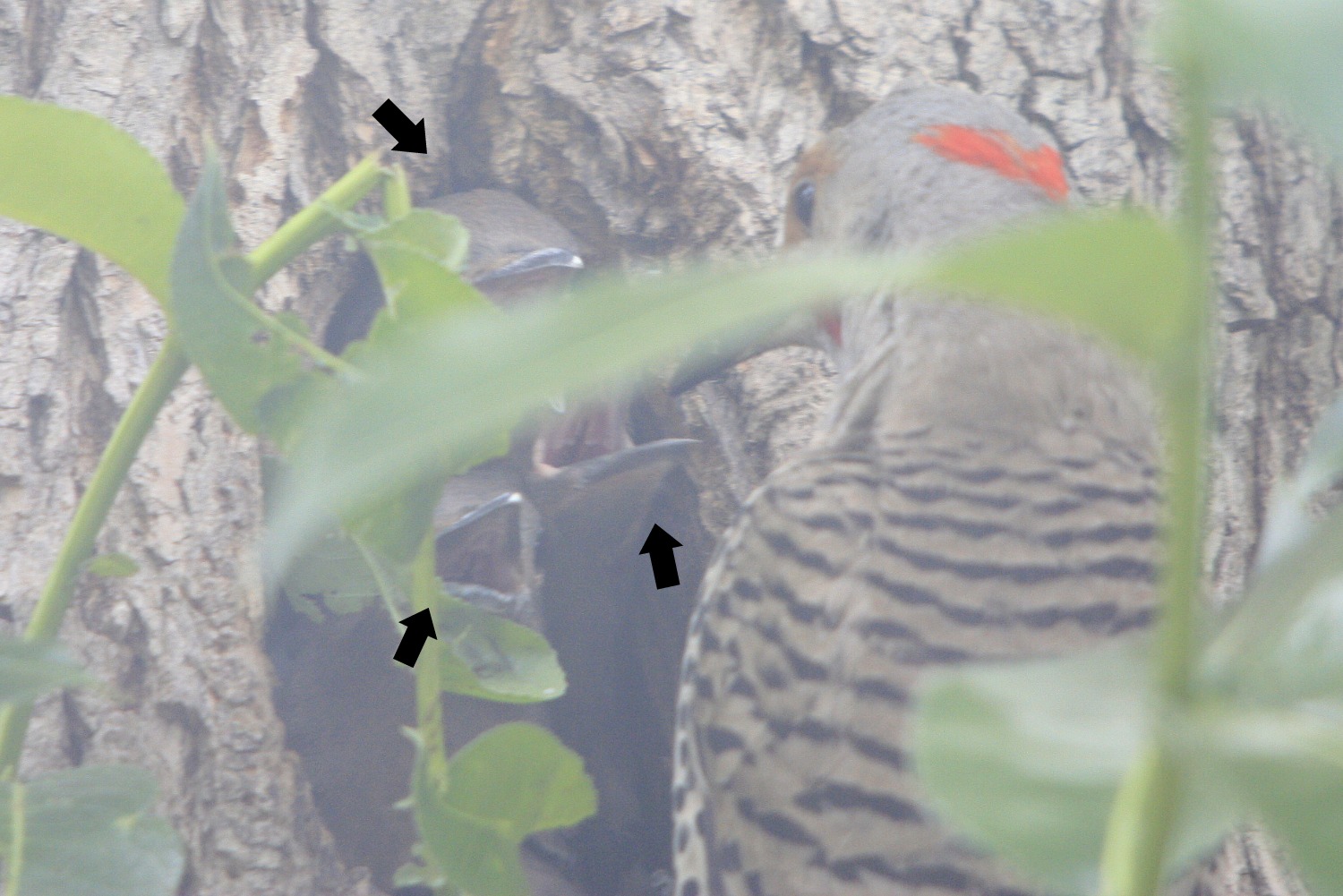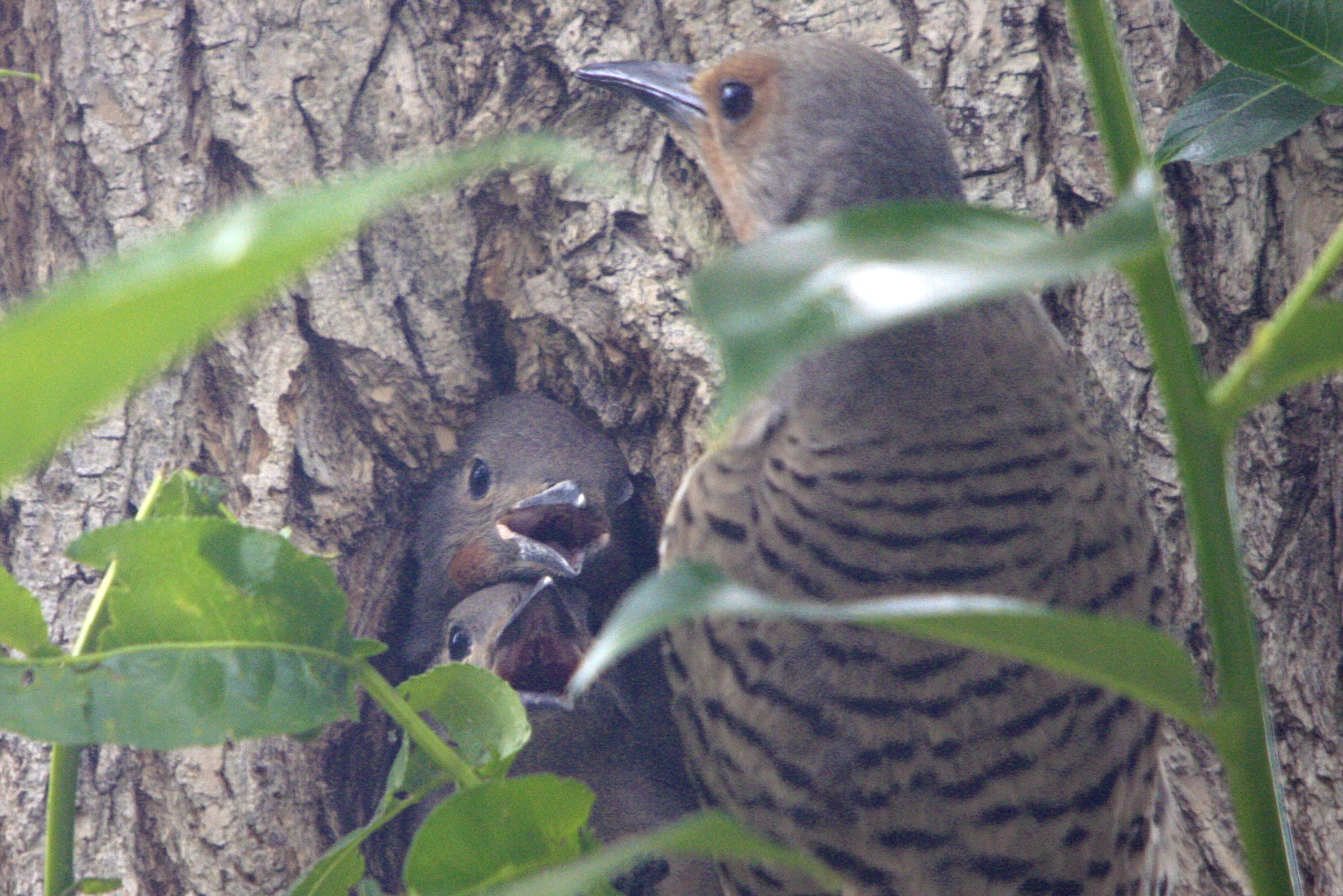Snow buntings are notoriously difficult to photograph, as they’re always in motion. Duane Starr was lucky to run into thousands & thousands of them and managed to get a series of wonderful pictures of these hyperactive little birds. He says when the flock was in the air they were everywhere and when they were on the ground they were everywhere. Click here to view his snow buntings on the fence, in the air, on the ground…
Archives
Rare Bird Alert Calgary: March 1
Have you seen an unusual bird in Calgary? If it is on this Reportable_Birds (PDF), please report it to the Nature Calgary Rare Bird Alert line at 403 221-4519 and leave a message after the beep at the end of the recording. If you would like some help with species identification, us email us at birdscalgary@gmail.com. To report injured wildlife call the Calgary Wildlife Rehabilitation Society at 403 239-2488, or the Alberta Institute for Wildlife Conservation at 403 946-2361.
February 25
– –MALLARD (leucistic female) Beaverdam Flats in SE Calgary, Rob English
–SPOTTED TOWHEE, farm ca. 5 km. N of Irricana, John Corbin 403-935-4340
February 26
–NORTHERN SHRIKE, Weaselhead Natural Area, SW Calgary, Phil Quinn – February 28
–CACKLING GOOSE, Mackenzie Meadows, Phil Quinn
– –GREATER SCAUP, Hwy 22x bridge E end of Fish Creek Prov. Park, Terry Korolyk
– –SNOW BUNTING (60), N. of Linden, Corinne Griffin
– –COMMON GRACKLE, Lynnwood subdiv., SE Calgary, Pat Bumstead
February 29
–GREAT BLUE HERON (6) Southland Dog Park parking lot, Deerfoot Tr. And Southland Dr., observer unknown
– –KILLDEER, Bow R. S. of Glenmore Tr. Bridge, Gus Yaki,
–
The next scheduled update of the Bird Alert is on Monday, March 5.
BIRD STUDY GROUP – Meets the first Wednesday of the month, September – May at 7:30 pm, Room 211, BioSciences Building, University of Calgary. The next meeting will be Wednesday March 7. The program is titled “High Science: The The Natural History of Alpine Ptarmigan”, by Kathy Martin.
Snowy Owl Action Shots
Duane Starr has had some excellent snowy owl luck lately, and sent us a couple of links to his photo galleries.
The first set has some wonderful in-flight and action shots. Click here to view, then click on Slideshow on the right hand side.
His second set of snowy pictures shows the complete sequence of an owl coughing up a pellet, which looks like an extreme amount of hard work! View here.
Wednesday Wings: Leucistic Mallard
Rob English has sent us some photos of the leucistic (white) mallard duck that’s been hanging around Beaverdam Flats this winter. Click photos to enlarge.
This bird is getting a lot of attention from photographers. Duane Starr has more views of this beautiful bird you can view in his photo gallery.
Sunday Showcase: Pileated Woodpecker
Rob English got these last Friday in Carburn Park in southeast Calgary, and says this was the first time he’d ever managed to see one there. The bird was so easy going he couldn’t stop taking pictures. When she did fly it was only 50 or 60 feet so he stayed with her for about an hour just shooting and watching her peel bark. Click on the photos for a larger view.
Rare Bird Alert Calgary: Feb 23
Have you seen an unusual bird in Calgary? If it is on this Reportable_Birds (PDF), please report it to the Nature Calgary Rare Bird Alert line at 403 221-4519 and leave a message after the beep at the end of the recording. If you would like some help with species identification, us email us at birdscalgary@gmail.com. To report injured wildlife call the Calgary Wildlife Rehabilitation Society at 403 239-2488, or the Alberta Institute for Wildlife Conservation at 403 946-2361.
February 17
–GYRFALCON, overflight, oxbow at W end of Glenmore Reservoir, Weaselhead Natural Area, SW Calgary, Phil Quinn (403-802-0568)
February 20
–SHARP-TAILED GROUSE, photographed in her back yard in Coach Hill, SW Calgary, by Myrna Belyea, (403-246-6071)
– –SNOWY OWL (12), in Irricana Slough area between Range Roads 253 and 264, Frank Wood
February 21
–GOLDEN-CROWNED KINGLET, W quarter of Fish Creek Provincial Park, Phil Quinn
February 22
–PRAIRIE FALCON, N end of Nose Hill Park in NE Calgary, PQ
–PEREGRINE FALCON, S of Okotoks, Brian Elder, Mike Mulligan (403-232-1013), RayWoods
–SHARP-TAILED GROUSE (17) SW of Nanton, same
–SNOWY OWL (3) Frank Lake, same
–MOUNTAIN CHICKADEE, Bebo Grove, W end of Fish Creek PP, Nemali Seneviratne
–DARK-EYED JUNCO, same, same
–BREWER’S BLACKBIRD, Nose Hill Park, near intersection of Shaganappi Trail and John Laurie Blvd, PQ
–
The next scheduled update of the Bird Alert is on Monday, February 27.
BIRD STUDY GROUP – Meets the first Wednesday of the month, September – May at 7:30 pm, Room 211, BioSciences Building, University of Calgary. The next meeting will be Wednesday March 7. The program is titled “High Science: The Natural History of Alpine Ptarmigan”, by Kathy Martin.
Monitoring a Flicker nest
Posted by Matthew Sim
As spring approaches once again, I like to reminisce about the previous year and all of its most exciting moments.
For the past several years, flickers have nested in my neighbor’s tree. I had never really observed this nest closely before; however, last year, I did just that. Flickers usually excavate nest holes in dead or dying tree trunks or large branches. These nest holes are most often found at 6-15 feet off the ground and will often be reused. By late May/ early June in Calgary most flickers have laid their 5-8 white eggs. I started to notice that the flickers were more active around the nest in early June and it is my belief that on around the 3rd or 4th of June, “my” pair laid their eggs.
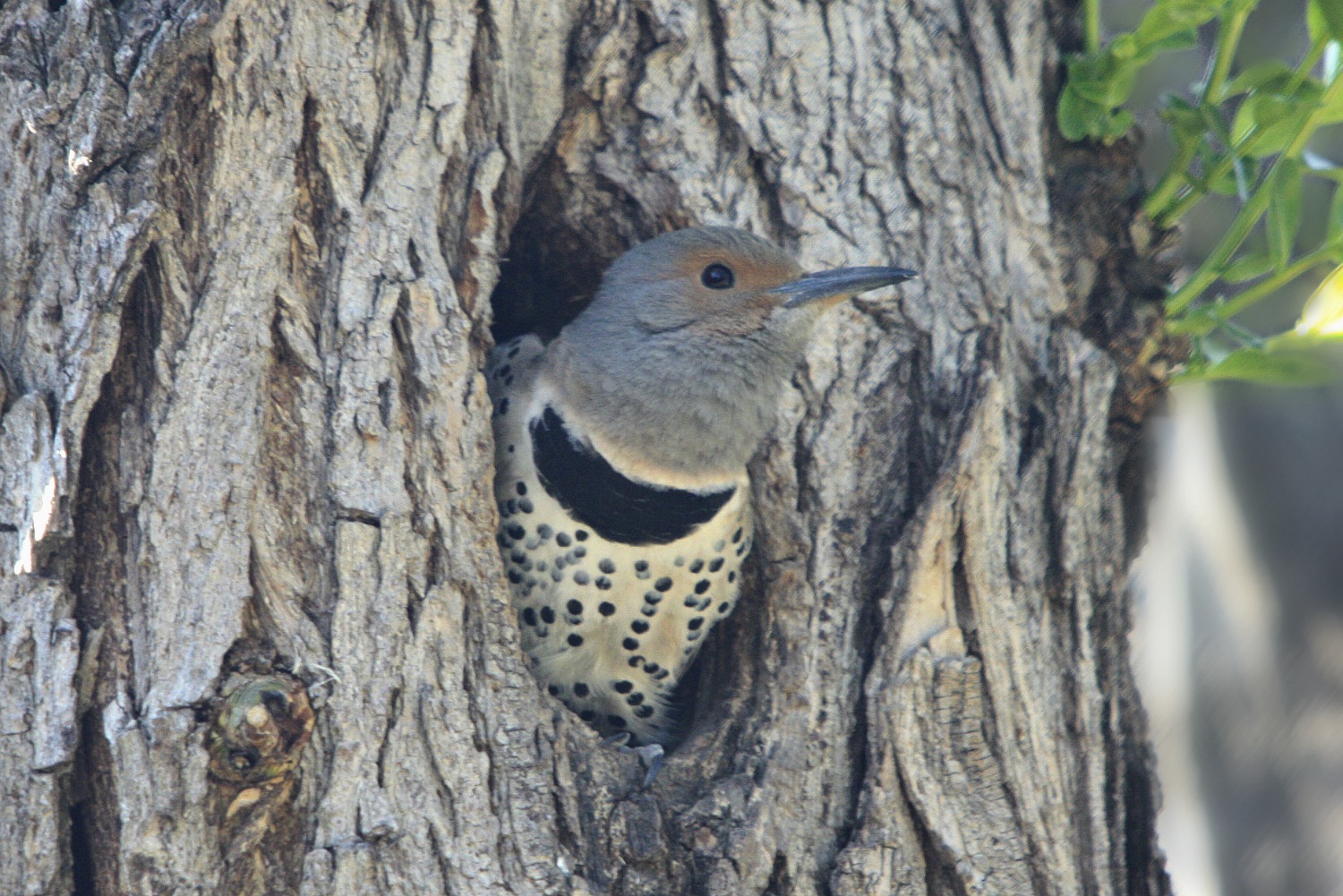
- This is the nest hole with the female looking out on June 10. The flickers had been in and out of the hole since late May
Incubation of the eggs ranges from 14-16 days and I had been closely following all the bird’s actions in attempt to discover when the eggs would hatch. On June 24, I heard the first sounds coming from the hole. The flickers had been born! I think that we can assume that there is a possibility that the young flickers were born a day or two earlier and I had not heard them until then.
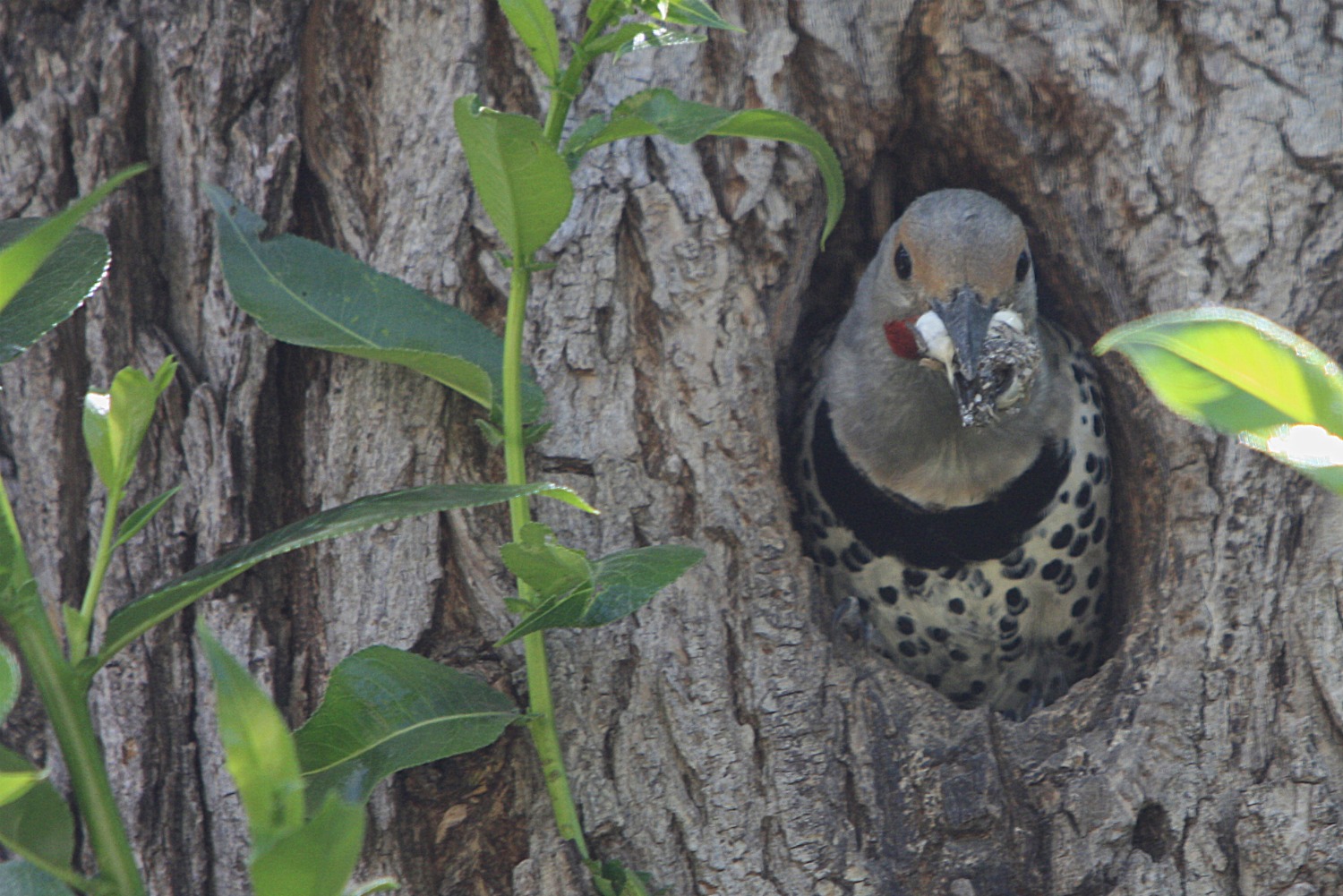
If you compare this shot with the photo above, you can see that the leaves around the hole grew a lot as the summer progessed, adding even more security and privacy to the flicker residence.
The first visible evidence of the young flickers was the clean-up crew. As all parents can attest to, there is a lot of cleaning up involved with kids. The adult flickers, both male (pictured in photo above) and female, had to work constantly to ensure that their young were well-fed, safe from predators and, perhaps most importantly, in a clean home.
July 1st came around and I had still not seen the young flickers, though I had definitely heard them. Each and every day they were getting louder and louder and soon I could hear them from across the alley, in my yard, maybe 35 feet away. The young flickers cry is often described as a hissing noise and is uttered for two weeks, day and night, growing stronger as the birds grow older. I was not worried about not having seen the flickers yet as their eyes do not open until they are ten days old, so wouldn’t be seeing them until then. July 3, I was up in Banff, where I happened upon a flicker nest with two young already poking their heads out of their hole. At that point, I couldn’t help but wonder how my flickers were doing.
July 5th, marked a special day for my monitoring project. That day, I got my first glimpse of the young flickers. I took my first photos of the young flickers on July 9th, and they were looking healthy and fit; all 3 of them!
But that’s where it went all wrong. The nest holes of flickers (and often of many other species of birds) are the scenes of very fierce battles. Three young birds with very sharp bills, duking it out for supremacy and the right to remain looking out of the nest hole, therefore receiving the most food. The stronger birds almost invariably end up on top, and maintain their authority by jabbing the others with vicious pecks of their beak. The opening is only big enough for two heads and the third one gets pushed to the bottom. There, the young flicker receives very little food and consequently, it perishes. July 9th, I took the photo above, showing 3 young flickers. By the next day, July 10th, I was only seeing 2 young flickers.
Disappointed though I was, I realized that sometimes, this is the way nature must work. I continued to watch the flickers for several days, amazed at the rate at which they grew. After about 4 weeks, the flickers would fledge and would begin to leave the nest; my flickers started appearing out of the nest around July 16th. The two young birds started hopping about and practicing flying, getting ready for the day when they would leave the nest altogether.
Than one day, I did not see the flickers. Nor did I see them the next day. Or the day after that. It would seem that the two young flickers that I had watched for a nearly a month had successfully fledged. I don’t think I ever saw these two again, though I was seeing flickers in the neighborhood, which might just have been one of the young. From time to time, I did hear the distant call of several Northern Flickers and I couldn’t help but wonder if it was the fledgelings, calling away.
Rare Bird Alert Calgary: Feb 20
Have you seen an unusual bird in Calgary? If it is on this Reportable_Birds (PDF), please report it to the Nature Calgary Rare Bird Alert line at 403 221-4519 and leave a message after the beep at the end of the recording. If you would like some help with species identification, us email us at birdscalgary@gmail.com. To report injured wildlife call the Calgary Wildlife Rehabilitation Society at 403 239-2488, or the Alberta Institute for Wildlife Conservation at 403 946-2361.
February 18
— RED-BELLIED WOODPECKER, George Lane Park, High River, AB, Yousif Attia
— HORNED LARK, Frank Lake area, Andrew Slater
February 19
— HORNED LARK, NW of Strathmore, Terry Korolyk & CFNS Group
— AMERICAN TREE SPARROW (25+), Irricana Sloughs area, Tony Timmons, Howard & Lynn Heffler
— GYRFALCON (gray morph), Frank Lake, Andrew Slater; adult female dark gray morph on 226 Ave. SW Terry Korolyk
— GRAY JAY, Bebo Grove/Shannon Terrace, FCPP, Bob Lefevre, Dan Arndt, FFCPP Group
— AMERICAN THREE-TOED WOODPECKER, as above
— NORTHERN HAWK OWL (2), Grand Valley Road, Jeff Bingham
— COOPER’S HAWK, possible sighting west Fish Creek PP, Gus Yaki
— NORTHERN GOSHAWK (2), Big Hill Springs PP, Steve Kassai
— SNOWY OWL, Hwy 1 & 84St NE (in the city), Brian Elder, Ray Woods
— DARK-EYED JUNCO, SW Calgary, Phil Quinn
The next scheduled update of the Bird Alert is on Thursday, February 23.
BIRD STUDY GROUP – Meets the first Wednesday of the month, September – May at 7:30 pm, Room 211, BioSciences Building, University of Calgary. The next meeting will be Wednesday March 7. The program is titled “High Science: The The Natural History of Alpine Ptarmigan”, by Kathy Martin.
Sunday Showcase: Golden Eagle
Have you ever wondered how the Golden Eagle got its name? These outstanding photos from Paul Turbitt answer that question. Paul took these juvenile eagle pictures at The Ann & Sandy Cross Conservation Area (ASCCA) just south of Calgary. If you haven’t visited this magical place, put in on your to-do list!
The ASCCA is open to the public, but visitors must make a booking online prior to their visit. Upon arrival, you must also register at the kiosk and pay the $2/person user fee.
Wednesday Wings: Bathing Merlin
If you’ve taken any pictures of interesting birds in the Calgary region, you can share them with us by emailing birdscalgary@gmail.com and we may post them on the blog.
Dave Arnold took these great shots of a Merlin having his Sunday bath on the edge of the Bow River. Thanks for sharing, Dave!
Ian Chatt also witnessed this and got these three photos:























